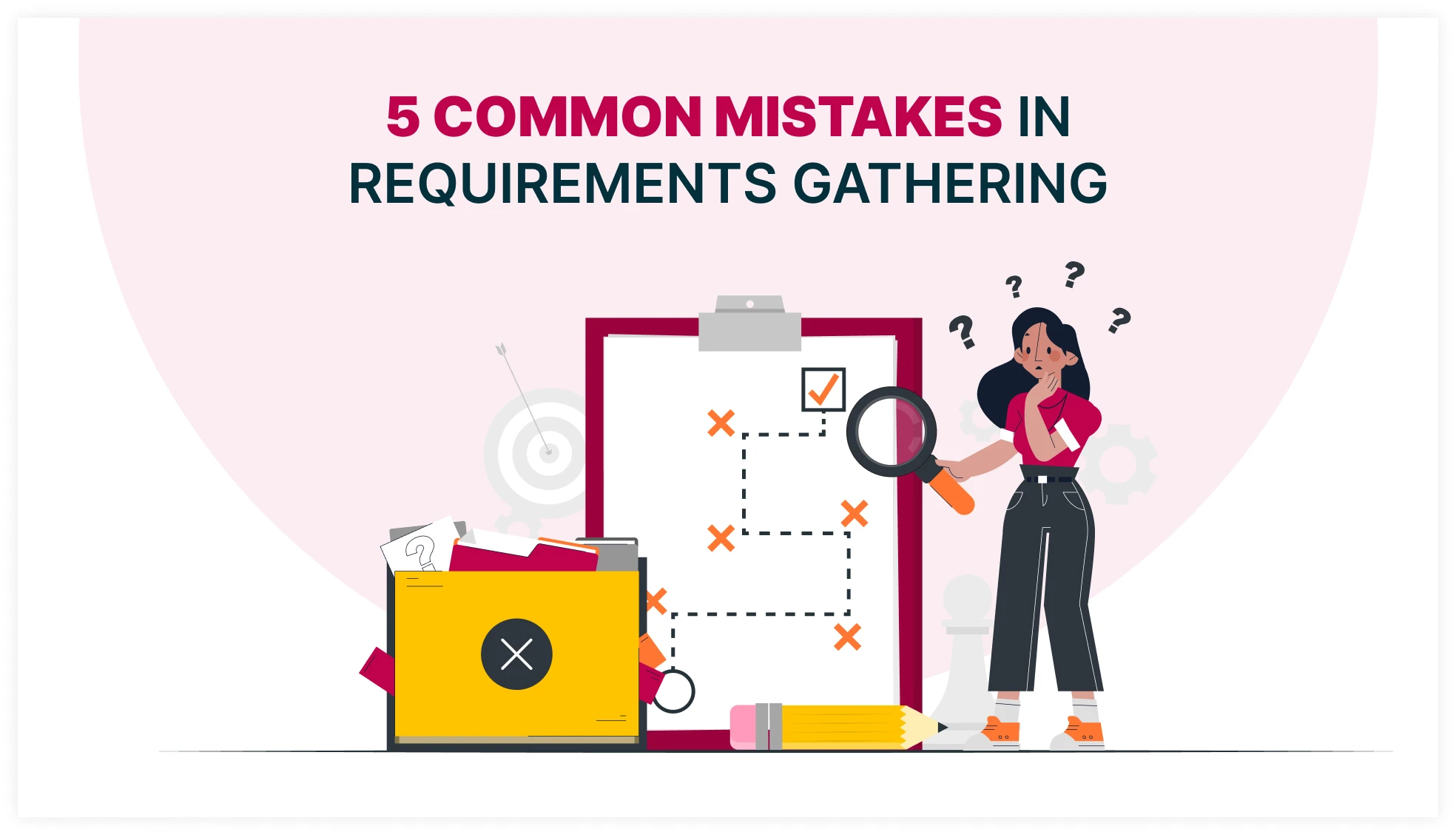
Requirements gathering is always considered the first step in any project. Because, it helps define what the project needs to succeed. Clear requirements lead to better planning and execution. However, mistakes during this step can cause big problems. These mistakes can delay projects, increase costs, or lead to failure.
In this well researched blog, we will discuss five common mistakes about requirement gathering and we will also talk about how to avoid them.
5 Common Mistakes in Requirements Gathering
Requirements gathering is an important step in project management.
Avoiding common mistakes ensures better project success. Here are the 5 common mistakes in requirement gathering:
1. Lack of Stakeholder Involvement
Failing to involve stakeholders is one of the most common mistakes in project management. Stakeholders play an important role in shaping project requirements.
Their input is very important. It helps ensure the project meets actual business needs.
Ignoring the stakeholders input can lead to incomplete, irrelevant, or misunderstood requirements. And that ultimately results in derailing the project.

Impact on Project
This often results in costly changes later in the project. To avoid this, ensure that all key stakeholders are engaged and remain involved throughout the process.
How to Avoid This
Regular meetings and clear communication help align everyone’s expectations. Gathering requirements without key stakeholders leads to failure.
Stakeholders provide valuable insights that guide the project. Without them, expectations can be unclear and needs unmet.
2. Ambiguous Requirements
Ambiguous requirements are another common issue that makes it difficult for teams to deliver the right solutions.
Poorly defined requirements create confusion and misalignment which prevent teams from meeting expectations effectively.

Impact on Project
For example, saying “Make the interface user-friendly” without defining what “user-friendly” means can lead to confusion.
How to Avoid This
Clear, detailed requirements reduce misunderstandings and help prevent scope creep. Use visual aids, user stories, or mockups to clarify expectations whenever possible.
Unclear project goals make gathering requirements difficult. Without clear direction, requirements can be unfocused and confusing. This can push the project off track.
3. Ignoring Technical Feasibility
Moreover, sometimes, teams set ambitious goals without considering technical constraints. This can result in unrealistic deadlines, overburdened resources, or even project failure.

Impact on Project
When technical feasibility is ignored, teams may find themselves working toward unrealistic expectations. This often leads to missed deadlines, exhausted resources, and significant rework.
In extreme cases, the project may fail because the goals simply cannot be achieved within the given constraints.
How to Avoid This
Collaborate with your technical team early to assess what’s feasible within the given timeline and budget.
Be in touch daily with the technical team to confirm that the goal can be achieved with the available resources. This ensures that your requirements are practical and achievable.
4. Failure to Document Requirements Properly
Even the best discussions can be forgotten or misunderstood without proper documentation. Poorly written or missing documentation creates confusion, delays, and frustration among team members.

Impact on Project
When requirements are not documented properly, teams lack a clear reference point, leading to mistakes, misalignment, and scope creep. Misunderstood requirements often result in rework, wasted effort, and delayed project delivery.
How to Avoid This
To avoid this, it is important that team members need to document all the requirements properly. They can do so by using different tools like Jira and Confluence.
5. Insufficient Validity and Review
Requirements need to be checked and reviewed multiple times to ensure accuracy. Skipping this step can result in missed details or costly errors.
Small inaccuracies can snowball into larger problems during the later stages of the project. Regular reviews also help uncover inconsistencies or gaps that might otherwise be overlooked.

Impact on Project
When requirements are not properly validated, critical mistakes or omissions can occur. This usually leads to costly rework, delays, and project misalignment.
Unchecked requirements may fail to meet stakeholder needs or technical constraints, which can derail the project entirely.
How to Avoid This
Involve stakeholders, team leads, and technical experts to validate the requirements. Regular reviews and feedback loops help keep the project on track and aligned with its goals.
Also, continuously review the requirements to ensure they are still relevant and make adjustments if necessary.
By prioritizing validation, teams can identify and resolve issues early, preventing costly mistakes down the line.
How to Avoid This
Involve stakeholders, team leads, and technical experts to validate the requirements. Regular reviews and feedback loops help keep the project on track and aligned with its goals.
Frequently Asked Questions
1. What is a common challenge in requirements gathering?
A common challenge is unclear or vague requirements. When requirements are not specific, it can lead to confusion and missed expectations. This often causes delays and scope changes during the project.
To avoid this, it's important to clearly define and document each requirement from the start. Regular communication with stakeholders helps keep everything on track.
2. What is a common error in requirements analysis?
A common error is failing to involve all key stakeholders. If important people are left out, their needs and expectations may not be captured. This can lead to incomplete or incorrect requirements.
To avoid this, make sure all relevant stakeholders are included in the analysis process. Regular feedback ensures everyone’s needs are understood.
3. What makes a bad requirement?
A bad requirement is vague, unclear, or unrealistic. It lacks specific details, making it hard to understand or implement. Bad requirements can lead to misunderstandings and errors during the project.
To avoid this, make sure requirements are clear, detailed, and achievable. Regularly review them to ensure they stay aligned with the project goals.
4. What are the 5 stages of requirement gathering?
The five stages are initiation, elicitation, analysis, documentation, and validation. First, you define the project’s goals and identify stakeholders. Then, you gather information through discussions and surveys.
After analyzing the data, you document clear requirements. Finally, you validate the requirements with stakeholders to ensure they are accurate.
5. What are the different requirement-gathering techniques?
Common techniques include interviews, surveys, and focus groups. Interviews allow direct conversations with stakeholders for detailed input.
Surveys and questionnaires gather responses from a larger audience. Focus groups involve group discussions to identify needs and preferences. Other methods include observation, document analysis, and prototyping to visualize requirements.
Conclusion
Requirements gathering is a key step for project success. Avoiding common mistakes ensures smoother progress and better outcomes. Involve stakeholders early, define clear goals, and document everything. Regular reviews and feedback help keep the project on track. By following these tips, you can gather accurate requirements and set your project up for success.



















